Preyed on by the pandemic
More than 11 million migrant labourers returned to their villages during the COVID-19 pandemic. Despite several government welfare schemes, even a year later, most continue to suffer the consequences of the lockdown as their livelihoods are derailed and their earnings reduced by half.


While they had earned reasonably well in the cities, now many migrant workers were forced to take up whatever job they could find. Photo: Gaon Connection
A year has gone by since the first nationwide COVID-19 lockdown. Before that, 40-year-old Amar Singh Yadav worked in a factory at Ghaziabad in Uttar Pradesh, earning Rs 12,000 a month. But now, he is back in his village, Salpur Navadiya near the Behgul river in Shahjahanpur district, 170 odd kilometres from the state capital, Lucknow.
Yadav is now employed as a night guard at a local trader’s place and earns Rs 100 a day, and is struggling to make ends meet.
With no work in the village, he managed for a few days by selling the little bit of ration he had with him, but soon was forced to mortgage his land. “A neighbourhood trader took pity upon me and gave me the job that pays me a hundred rupees a day,” Yadav told Gaon Connection.
There are many others who, like Yadav, worked in big cities but were forced to return to their village during the pandemic. While they had earned reasonably well in the cities, now they were forced to take up whatever job they could find.
At Turkauli Gram Panchayat in Barabanki district of Uttar Pradesh, about 175 kms away from Shahjahanpur, 43-year-old Amir Hassan, a truck driver in Delhi for nearly 20 years, returned to his village. “This year’s Holi marks a whole year, since my return from Delhi,” Hassan told Gaon Connection. He has no money to buy a vehicle for himself. While back in Delhi he earned Rs 10,000 a month, he now earns Rs 200 a day working as a daily wager at a watermelon farm. “Somehow, I am managing to support my family,” said Hassan who had also contracted COVID-19.

“The people of the village are amazed that I am still able to work a spade but then, desperate times call for desperate measures. I have three boys and a daughter who are studying at school,” said Hassan who pleaded with the school principal to waive off his children’s fees which he did. According to Hassan, the free ration received from the government during the lockdown was not adequate to cover their needs.
Meanwhile on February 8 this year, the Union minister of state for labour and employment, Santosh Gangwar, informed the Lok Sabha that more than 11.5 million returned to their villages during the lockdown. Of these, the maximum migrant workers returned to Uttar Pradesh (3,249,638), followed by Bihar (1,500,612) and West Bengal (1,384,693). The migrant workers came back home, in their thousands, with no money, job or food. While some went back when the lockdown was lifted, many of them chose to remain in their villages.
Gangwar also said that skill mapping is being conducted to increase employability of rural migrant workers. The project has a resource of Rs 500 billion and is currently being undertaken across 116 districts in six states. So far, it has created 507,868,671 work days. He added that Rs 2.95 billion had been disbursed to more than 200,000 migrant labourers.
However, many like Yadav of Shahjahanpur and Hasan of Barabanki had slipped through the cracks and had received no succour whatsoever.
“The government wage situation has deteriorated,” Nikhil Dey, a social activist and founder member of the Mazdoor Kisan Sangathan, told Gaon Connection. According to him, for those who are engaged in the unorganised sector there has been hardly any demand in the market. Making things even more difficult for the labourers and the workers were the travel restrictions and night curfews in many places.
Also Read: More than 40 crore workers in India’s unorganized sector may be affected due to the lockdown: ILO
Government welfare schemes
In order to help out the migrant labourers who had returned to their villages, the minister for labour and employment said, state welfare boards had disbursed nearly Rs 10 billion during and after the lockdown towards employment to construction workers. Further, under the Garib Rozgar Kalyan Abhiyan, the government launched the SVANidhi Yojna to provide working capital loans of Rs 5 million to compensate five million hawkers for their loss of livelihood due to COVID-19 and lockdown.
Also Read: Less than 40% loan applications made by street vendors to the PM SVANidhi scheme sanctioned
The union minister also said that the government had commissioned new construction through the Ministry of Transport and Highways in order to provide employment to migrant workers. Meanwhile, the Department of Biotechnology has set up 30 biotech-kisan hubs in 150 districts including 101 aspiring districts in the country. These will assist migrant workers, who earn their livelihood through farming, by giving them technical assistance in cultivating better-earning crops.
Also Read: Could the ongoing COVID-19 pandemic help rethink informal sector issues in India?
Bleak days ahead
Meanwhile, despite all these welfare measures, farmer Kashiram, who owns two acres (0.51 hectare) of land in Palhari village, Barabanki, is forced to earn his living as a daily wage labourer at a mustard farm. While he once earned Rs 10,000-12,000 a month installing water tanks over houses in Surat, Gujarat, he now earns nothing more than Rs 200 a day, barely enough to look after his family of 12.

“I could not leave again for the city after the lockdown was lifted,” Kashiram told Gaon Connection. The only help he received from the government was some rations.
Activist Dey warned of worse days ahead for the migrant labourers. “During the lockdown, migrant labourers and workers had the option of the MGNREGA (Mahatma Gandhi Employment Guarantee Act), but payment to them has stopped since last month,” he pointed out. “The new budget will, therefore, be utilised to settle the pending payment of wages from last year. Since the budget for MGNREGA has already suffered a major cut, the labourers will face further paucity of work opportunities,” he said.
In the General Budget (2021-22), the government has allocated Rs 730 billion to MGNREGA, which is higher than the previous year’s budget, but 34.5 per cent lower than its revised estimate of Rs 1,115 billion.
To ascertain the impact of the lockdown, Gaon Connection conducted a survey among 25 states of the country between May and July 2020. Seven out of every ten people surveyed (71 per cent) said that their family income had declined during the lockdown, while nine out of every 10 (89 per cent) said they suffered economic hardships in one form or the other during the lockdown.
Meanwhile, last month, the Labour Bureau of India launched two national surveys. The first will study the working conditions of migrant labourers, their living conditions and the impact of COVID-19 on their area of work.
The second survey will be conducted among companies/institutions to establish livelihood projections and provide vital data on quarterly-basis about the shift in the state of livelihood in selected areas.
Finding their way home to self reliance
However, some of the migrant labourers who returned to their villages made the most of it and set up businesses.
Shubham Bonde and Vishal Gore, friends from the same village of Salod in Wardha district in Maharashtra were employed in Pune and Nagpur, respectively and each one earned close to Rs 350,000 annually.
When industries shut down during the lockdown, both returned to their village. Together, they started their own food packaging business with a bank loan of Rs 500,000. According to Bonde, the small farsan (Indian snack) packaging unit that they started in 2020, is doing steady business and they are able to provide employment to three others in the village at a salary of Rs 6,000 each per month.
With inputs from Chetan Bele in Wardha and Ram Ji Mishra in Shahjahanpur.

